
| Notes about: | |
 |
Anthology/One |
 |
Love Letter on a Fish |
 |
Michael Margaret Pat & Kate |
 |
Michael Smith / Love Stories |
 |
Old Man Dancing |
 |
There |
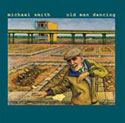
Michael's notes about recording:
OLD MAN DANCING
"Old Man Dancing" was the first group of songs that I got right. The songs are consistent with one another, that is, I didn't think, thirteen months down the road: Why did I put that song in with those others? This had been a common occurrence before. And I didn't get crazy sonically, and the parts I played were reasonable and appropriate. And once I got rid of all my removable faults, I found that what I'd made was just what I wanted. I didn't feel like I had to apologize for it a year later. I think it's the best thing I've done. It is just what I had in mind.
The first song, "Accokeek", is about a murder, which I read about in the Newark Star-Ledger when I was visiting my good friend Dave Jeffreys in Ortley Beach. And this murderess was so dopey and primitive that the only way to react to her songwise was to make the song kind of gleeful, like "Mack The Knife", or Edward Gorey. "Sure Has Grown" is about Pittston, Pennsylvania, where my grandparents lived, a town I love in memory. "Ghost of Lash LaRue" continues my obsession with old western movie stars. The fourth is a hipster retelling of "The Picture Of Dorian Gray", by Oscar Wilde. "Poor Maurice" was me romanticizing myself (maybe on acid) when I was thirty. "Roger Maris" and "Ballad of Phil Spector" were written in (rare) moments of empathy. "Edward G. Robinson" was inspired by reading a Dear Abby column where folks wrote in, detailing good turns that had been done for them by Edward G., and me thinking: what if he had done all those things for me? "Pittston Stove" is about a Pittston Stove.
(Nov 2013) Back to Old Man Dancing CD page
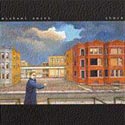
Michael's notes about recording:
THERE
I worked on this recording for three years approximately 1998 to 2001. I did basic tracks at Dr. Caw Studio playing acoustic guitar with a great bassist, Eric Hochberg, and drummer, Jim Widlowski, and then took the tracks home and listened to them over and over, to see what else I wanted on them. At that time I liked the idea of having a LOT of instruments on a song. I was working at home with a digital recorder lent me by my friend Anne Hills. The recorder used videotapes for a medium, which was interesting to me, for the videotapes didn't like it if you did too many takes in the same spot, and the recorder would abruptly decide for you what was your last take, like an annoyed (and annoying) producer. I learned to outwit the recorder, but it took a lot of time and I don't record on that machine anymore, though at the time I was thrilled to have it.
I borrowed a guitar synthesizer from my friend and heavy guitarist Pat Fleming, who was very encouraging to me through the whole process. With that synth, a Roland, I think, and my various guitars and keyboards I did all the other instruments on the album. The exceptions were the strings on "Hey Kid" and "Memory of August", by Miriam Sturm (who has played in John Mellencamp's band for years) and Sara Wollan, the accordion on "Hey Kid", which was done by Willy Schwartz, and the percussion on "Look Look" and "Alexandria", by Jeff Thomas. I should have used Willy for more things on that album for he surely is a master of exotic instruments but I think he was in and out of town quick (he lives in Germany). Did use Jeff on a subsequent recording: Anthology One.
THERE, my most expensive album so far, was financed by my friend and publishing supervisor Dolly Zander, from Austin, Texas. She had no idea that it would take three years to finish it. Neither did I, really. My idea was that I was finally going to record a whole album without abandoning it for lack of bread. I saw that the search for perfection can drive you (and Dolly) crazy, and to this day I find that there are only few moments of peace on that album due to my anxiety to fill up every space with Something Wonderful.
However I am very proud of the instrumental mood and power of "Alexandria" (Phil Bimstein wrote the music), in the lyrics for which I stole snippets of Lawrence Durrell, who wrote a daunting book of the same title. One of his lines I used that I like best is: "Life, like art, is an open secret". The first line of "Alexandria" is: "If you go to Alexandria, get me some hashish". That's not Lawrence Durrell, that's me. I am happy with "Hey Kid", which was inspired by the beautiful and intriguing paintings of my friend Leo Segedin of Chicago, one of which graces the CD cover. "Kill the Buddha" is a song I wrote in 1980 as one of two themes for a Japanese sword-fight movie (don't ask). I am proud of that song too, it has moments where it sounds like Lennon to me, though I never would perform it live. I liked "Rainy Season", also co-written with Phil Bimstein, on which I played a bunch of tracks with my friend Byron Cameron's mandolin. The first sound you hear on "There" is windshield wipers. I think the song "There" turned out to be very honest as a composition. I like the "dawdling" atmospherics before the rhythm kicks in for "Painted Horse". This CD sounds better when it's played loud.
As usual, it doesn't matter what album it is, the songs are like my children. As always, I certainly would enjoy doing this entire album all over again, or maybe parts of it. I never learn.
P.S. God knows Dolly Zander has done more to promote and protect my songs than anyone in the universe. Thank you, Dolly.
(March 2010) Back to There CD page
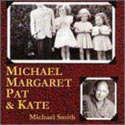
Michael's notes about recording:
MICHAEL MARGARET PAT & KATE
This was the recording that demanded the most emotional involvement from me, as it was the music that I played in an autobiographical theater piece at Victory Gardens in Chicago in 1993. The piece was facilitated and directed by Peter Glazer, who had written Woody Guthrie's American Song, which I'd enjoyed at Northlight Theater, also in Chicago.
I must say that after a while it became such emotional hard work to do this piece that I was contented that it didn't go much farther than a run at VG and a subsequent run at Marin County Playhouse. MMP&K did well for me at VG, though, winning four Jeffs, Chicago's equivalent of the Tony. I thought from then on I'd just be winning Jeffs out the wazoo, but time has shown me what a singular moment that actually was.
Some of the songs on the CD were written specifically for this piece: "Looking for Maureen", "Coffeehouse Days", "Patricia's Song" (which was a setting of a letter from my sister), and others were songs I'd had for a while that were (or purported to be) biographical in nature: "Sister Clarissa", "Elizabeth Dark", "Belmar". I do "Elizabeth Dark" with a different rhythm now, which annoys some people. I can relate, I used to hate it when people changed arrangements they'd already recorded, but I can't keep myself from doing it. I am very happy with the recording of "Little Falls", and I find it's great on headphones for when you want to walk briskly around the block where Selia Qynn lives. Pat Fleming (guitar) and Miriam Sturm (violin) and Willy Schwartz (accordion) are on this CD, and were in the show. I would like sometime to rerecord "Five Angels", it is an odd and heartfelt little tune, born of being caught in Catholicism, some of the lyric stolen from a beautiful book called The Yellow Book of Fairy Tales. I wrote it in the middle of the Longest Winter In The World (Detroit, 1972). Steve Goodman told me that John Prine said he'd considered covering it, a big thrill for me. I wrote "Belmar" during my last acid trip. It shows, I believe, right around the line about severed heads. The CD cover is from my sister Margaret's First Holy Communion.
My mom and my sisters came up to see the show, and this was a lovely experience.
(March 2010) Back to Michael Margaret Pat & Kate CD page
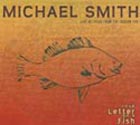
Michael's notes about recording:
LOVE LETTER ON A FISH
I had a very high energy level for this recording. It's almost embarassing.
This is the second recording done with the Tales From the Tavern folks, live, in circumstances similar to the first one. I like the recording of "Panther In Michigan". I think I got the right amount of intensity into it. I mixed up the words to "Tom Mix" a bit, though I'm proud of that song, which is very sincere, let me tell you. I think I swing with "Tom Dundee" better now, when it was recorded here it was comparatively new, as was "Barbara Dodd", although I think "Barbara Dodd" comes off better. I'm glad I did "Bees Bees Bees Bees Bees Bees Bees", and plan to do another album with all the Selfish Giant songs, that is re-record them. I also like "Rondi's Birthday", which was written during the run of The Grapes Of Wrath at the Royal George in Chicago for Rondi Reed, who is with the Steppenwolf Company. (Rondi was on Seinfeld being the neighbor who wanted everyone to hug hello.) I should mention that Anne Hills also recorded "Rondi's Birthday" very nicely on her October Child CD.
I think most people like my live albums best. Well, it is folk music, isn't it?
(March 2010) Back to Love Letter on a Fish CD page
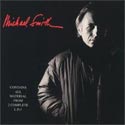
Michael's notes about recording:
MICHAEL SMITH / LOVE STORIES
This is actually two LP's combined on one CD. They are the first two recordings I did for Flying Fish, which was a label in Chicago right down the street from us, run by Bruce Kaplan, a bright man. I'd approached Bruce about recording before this, and since he didn't jump up and down immediately I was like, forget him. Anne Hills said oh I'll work all this out and she did. Anne produced both albums. One was called Michael Smith and the next one Love Stories.
Anne did a great job, coping with a person (me) who was very anxious about doing a recording by himself. Up to this time I'd always recorded in some kind of group situation, and though God knows I was aggressive about what I thought, still I wasn't in charge of the feeling. Now with Anne I actually got to go where I wanted to go, but I was conscious of wanting to come through in a reasonable way for her. I was paranoid about recordings in general, having had some unfortunate experiences in the studio, which I now realize were really pretty much caused by my own ignorance of the process. I would go from being scared to grandiose. Anne was very calm through the whole thing.
For both recordings we used Pat Fleming on lead guitar, Larry Gray on bass, and Julianne Macarus on violin. I wrote most of the arrangements but when things got technical Pat got in there to good effect. We recorded both albums at Dr. Caw, in Northville, with Craig Williams, who is a great guy.
I like a lot of this CD, especially "Demon Lover", a song I worked on for a long time and am proud of. It is a modern paraphrase of a medieval folk song called House Carpenter, which I'd heard on a Joan Baez recording. I first became aware of the ancient notion of the demon lover (and that traditionally his name was often James Harris) at 20 or so from an out-of-print paperback by Shirley Jackson called Adventures Of The Demon Lover. I loved that book and I love Shirley Jackson. Particularly because of how the melody emerged and the arrangement, "Demon Lover" became for me hipper than the average folk or pop song. I wish everything I've done could be as urbane and off-the-wall as that one turned out to be. Larry Gray of course is heavy and his bass solo at the end of Demon Lover is so poignant and perfect. The whole thing is like a really weird and arcane Mel Torme song.
I like "Loretta of The Rivers" and "Three Monkeys". I think those songs have a lot of mood, and I never get tired of the countermelodies. When I gave my late friend Mike Jordan (of the Rockamatics) a demo of "Loretta" he played the tape at Orphan's for an entire afternoon, which I confess I found a reasonable response. I thought everyone would have the same reaction, but I was wrong. If you don't get "Loretta" or "Three Monkeys" I understand. But I do think they're perfect, particularly "Loretta".
I'm not crazy about the way I did "Dutchman" here ("The Dutchman" was written for my sister Margaret and is kind of a Jacques Brel/Raspberries, Strawberries amalgamation, can you see that?), or "Spoon River". I like "Come Away Anitra" (it's not "Anita"; they misprinted it) and "Panther In Michigan". I still have fun singing "Panther", the designing of which opened up my head. The lyric to "Panther" is almost completely lifted from a Chicago Tribune article. I made up only one line: "And he's following the water, and the ways of the Indian."
I had written "Anitra" years before, and one day it occurred to me: you could make this sound just like "Panther". At fifteen I used to love when people would put out recordings that sounded just like their earlier ones, with similar chords and only slightly different words. Mickey and Sylvia did that, and Frankie Lymon and the Teenagers. You knew what you were buying 'cause you'd already bought it.
I think "Pompeii" and "Gauguin" are OK but belong on some different recording. Performancewise I did a better "Panther" on Love Letter On A Fish. 'Course I'd had twenty years to practice. "Colleen's Song" (misspelled "Coleen") was written for my daughter, who sang it with me when she was like three. "Dan Moody" was the name of a witness my wife Barbara saw at a trial in Bartow, Florida, when she was a child. People went to trials in Bartow for entertainment.
"Crazy Mary" is the first song I ever wrote (at 24) where I saw clearly: I truly don't care what people think of this, I know it's good.
I remain so grateful to Anne for making these recordings happen.
(March 2010) Back to Michael Smith / Love Letters CD page
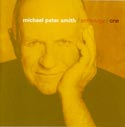
Michael's notes about recording: ANTHOLOGY/ONE
This CD was financed by John McDermott, who has done many good things for me. I've worked in Toronto with him a bunch of times, and been privileged to have his crack band accompany me in the shows.
On this CD I did some new songs and some songs that I wanted to reapproach. Sometimes it worked very well and sometimes it didn't. I played guitar and synth and bass, and Jeff Thomas did some drums and percussion. Sometimes it was just guitars. I used Anne Hills' beautiful twelve-string on some things.
I should say that whenever I make a CD I think it's hot stuff for about the first year after it's come out, and then I always get second thoughts, and third, etc.
Of course I'm not my typical listener, whoever that is.
People who verbalize to me about my recordings invariably seem to prefer just me and my guitar, and the hell with the rest of that stuff, although now and again someone will surprise me by actually professing to enjoy, say,There. I must say it seems only a certain type of person wants to offer me critical opinions about things I've recorded, and they are usually one-instrument-minded. I try to be polite. It's not that I don't care to please people, it's that for me pleasing people isn't all there is in music (to say the least). It's an exploration, I'm a little lost, and there isn't enough time. God knows I don't know where I'm going but even less do they.
Enough, enough. I like "Fun House", which I wrote when I was about 30, although I think for most it's an acquired taste. Even my sister Pat isn't crazy about it. It's eerie, I'll give it that. I am very proud of "Lavallette", which I wrote for my friends Dave and Cordelia Jeffreys' remarkable nieces. I wish I could figure out how to make "Blazing Guns" work, but it's not happening here. I am very proud of "Portrait of Isabel", and I think "Portland Fancy" is a good song. I took a couple of lines for that one from a old letter I read years ago that had to do with the Pullman strike in Chicago. "Dutchman" and "Panther" have their moments.
I called this record Anthology/One because I had notions of doing some more with the same cover only of different colors and numbering them, some old and some new mixed, like this one. I may do this yet. I'll pay for the next one myself. Thanks, John.
(March 2010) Back to Anthology One CD page
